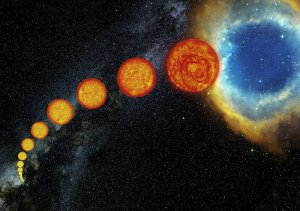
TWO WOBBLES MEAN TWO PLANETS
An international team of astronomers led by Bun’ei Sato of the Tokyo Institute of Technology discovered two new exoplanets revolving around HD 47366 – an evolved star located approximately 260 light-years from Earth that is estimated to be just 1.6 billion years old. That may seem like a long time, but keep in mind, our Sun is 4.6 billion years old.
Evolved stars are stars that completely burned out their hydrogen to initiate helium burning. At this stage, the star expands and transforms into a red giant (something that will happen to our own Sun in a few billion years). HD 47366 is almost twice the size of our sun.

The two exoplanets revolving around HD 47366 were discovered using a technique called Doppler spectroscopy and employed three spectrographs taken by three space observatories around the world. Doppler spectroscopy, which is also technically known as radial velocity method, uses gravity to identify exoworlds (aka alien planets).
So how did the scientists know that there were two planets revolving around the star?
The astronomers were looking for any indications of wobbling when observing the light being emitted by HD 47366. Typically, if the light of evolved stars wobbles, it means that an exoplanet is exerting a gravitational tug on them.
When observing HD 47366, the light wobbled twice within a short period time, hinting that there are two massive planets orbiting the star. Furthermore, the wobbles occurred within a short interval from each other, indicating that they are orbiting the star within a short distance of one another.
TWICE THE SIZE OF JUPITER
The newly discovered exoplanets, which are still unnamed as of this moment, are estimated to be twice the size of Jupiter. Astronomers calculated the mass of the planets by fitting a double Keplerian model to the radial-velocity numbers they gathered. Using this technique, they were able to compute that the inner planet is 1.75 the mass of Jupiter and the outer planet is 1.86 the mass of Jupiter.
The discovery is not without questions, however.
Two massive exoplanets orbiting a star so close to each other is rare. A dynamic analysis of the system also revealed that the best orbit models are unstable. In the paper detailing the discovery on arXiv.org under the Cornell University Library, the researchers said: “The planetary system is intriguing in the points that the best-fit Keplerian orbit is unstable, it is near but less likely in 2:1 mean-motion resonance, and could be stable if the orbits are nearly circular or in retrograde configuration.”
FORETELLING THE FUTURE OF OUR OWN SOLAR SYSTEM
As to why giant exoplanets are usually found orbiting evolved stars, the paper says: “It may be a primordial property of planets around intermediate-mass stars that could be an outcome of planet formation or an acquired one as a result of orbital evolution caused by stellar evolution (stellar tide and mass loss) of central stars.”
While there are still unanswered questions about these types of planetary systems, the scientists behind the discovery believe that further examination of the HD 47366 will shed light on how stable and unstable planetary systems form and evolve. It may also show us a glimpse on what could happen to our own solar system as the sun ages.